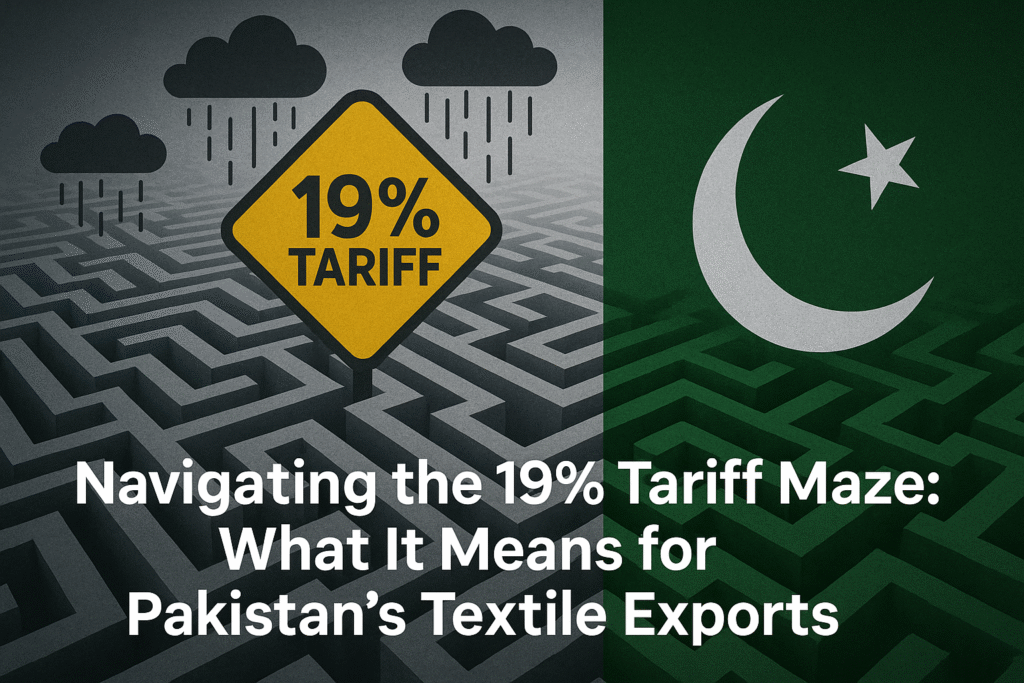
By: Muhammad Hasan Shafqaat CEO, Pakistan Textile Council (PTC)
03rd August 2025
While there is some clarity regarding the Tariffs, clouds of uncertainty will still shroud us for the next few months. To clearly understand the issue a quick recap might assist. For Pakistan (also rest of the world) this issue started when 29% Reciprocal Tariffs were imposed on 2nd April 2025 by the US. It is important to note that these reciprocal tariffs were over and above the MFN tariff being charged by the US from each country. After a week, a 90 days pause was announced, with a baseline tariff of 10% (MFN+10%) till 9th July 2025. The deadline was further extended till 1st August 2025.
After “comprehensive negotiations” a 19% tariff has been imposed on Pakistan. Which is being boasted as a big success by certain quarters. For a start it is agreed that we are not worse off in comparison to our competitors. But the tariff rate imposed is still very high. Industry was expecting a lower reciprocal tariff in the range of 10 to 15% as many high-level officials went to the US for discussions, including Deputy Prime Minister and Finance Minister etc. Pakistan reportedly offered to reduce the US$ 2.9 billion trade deficit between Pakistan and US by importing US cotton (to the tune of US$ 1 billion), importing Oil related products (to the tune US$ 1.2 billion) and other US products like Soya bean etc. Pakistan also offered to remove all non-tariff barriers as reported in US Trade representative report. But still the outcome of these negotiations has been largely “neutral”, if not worse.
All main competitors of Pakistan in US market including Vietnam, Cambodia, Sri Lanka and Bangladesh have now duties in the range of 19-20% (MFN+). Only India has 25% reciprocal tariff which is higher than Pakistan (6% difference). But with the economic muscle of India (in terms of regionally competitive cost of doing business), fiscal space available with the Government of India to provide a buffer through subsidies, rebates, interest free financing etc, this 6% difference can be easily absorbed by Indian exporters. So there is not much of a possibility of Pakistan either gaining or losing too much in the US apparel market. However, some US based buyers of Home Textiles might consider shifting to Pakistan, if Tariff on India does not come down in the coming months.
An other important aspect to consider is that what conditions will be attached with this new tariff particularly regarding the rules of origin. President Trump in his executive orders has specifically mentioned that goods transshipped will be charged the higher duties. Moreover, the executive orders he issued say: “Certain foreign trading partners identified in Annex I to this order have agreed to, or are on the verge of concluding, meaningful trade and security agreements with the United States. Goods of those trading partners will remain subject to the additional ad valorem duties provided in Annex I to this order until such time as those agreements are concluded, and I issue subsequent orders memorializing the terms of those agreements.” This clause is an indicator that tariffs can be adjusted in future for better or worse (for the exporting country). Moreover, if a condition is placed on Pakistan that raw materials, of only Pakistan and US origin, can be used, then Pakistan will not be allowed to use raw materials of Chinese origin, to get the tariff benefit. This can and will severely impact our SME sector, as Chinese raw materials are of good quality and low price.
Speaking of China, total additional reciprocal tariff in MMF based apparel is 30% and 37.5% for Cotton based apparel, respectively. The difference of 10% in MMF ( difference from 19% tariff on Pakistan) can be easily absorbed by Chinese companies as their cost of production is obviously very low in comparison to its competitors like Pakistan. However, major retailers and brands, might still like to shift sourcing out of China, given the uncertainty between US-China relations. The downside to this is that China will definitely be attracted to simply dump its textile products (not sold in US) in EU, UK and other like markets. Same thing can be exercised by India. Hence Pakistan will have to face a very tough competition in those markets.
One important other factor in this whole scenario is that average US tariffs has risen to 15.3%. Reportedly the US will earn US$ 420 billion in lieu of these additional duties. This cost of additional tariffs cannot be absorbed by either manufacturers or retailers. This will therefore be passed on to the US consumer. Due to this and inflation in the US, the demand of textile and apparel might be compressed by 5 to 10% approximately (as reported by different industry experts). However, things will become clearer in the coming months.
Finally to give any concessions to US, Pakistan will have to sign a Preferential Trade Agreement (a requirement under WTO rules). During these discussions of signing PTA, Pakistan’s Government must ask for duty free access in products of interest (especially apparel). This can be achieved given the concessions we are willing to give/offer to the US. If properly negotiated, this PTA can actually give us the advantage we expected. However, Government while negotiating, must constitute a team of both Industry experts and relevant government functionaries, to get maximum benefit out of these negotiations. Probably then we will be right to blow the “trumpet of success”, not now.
